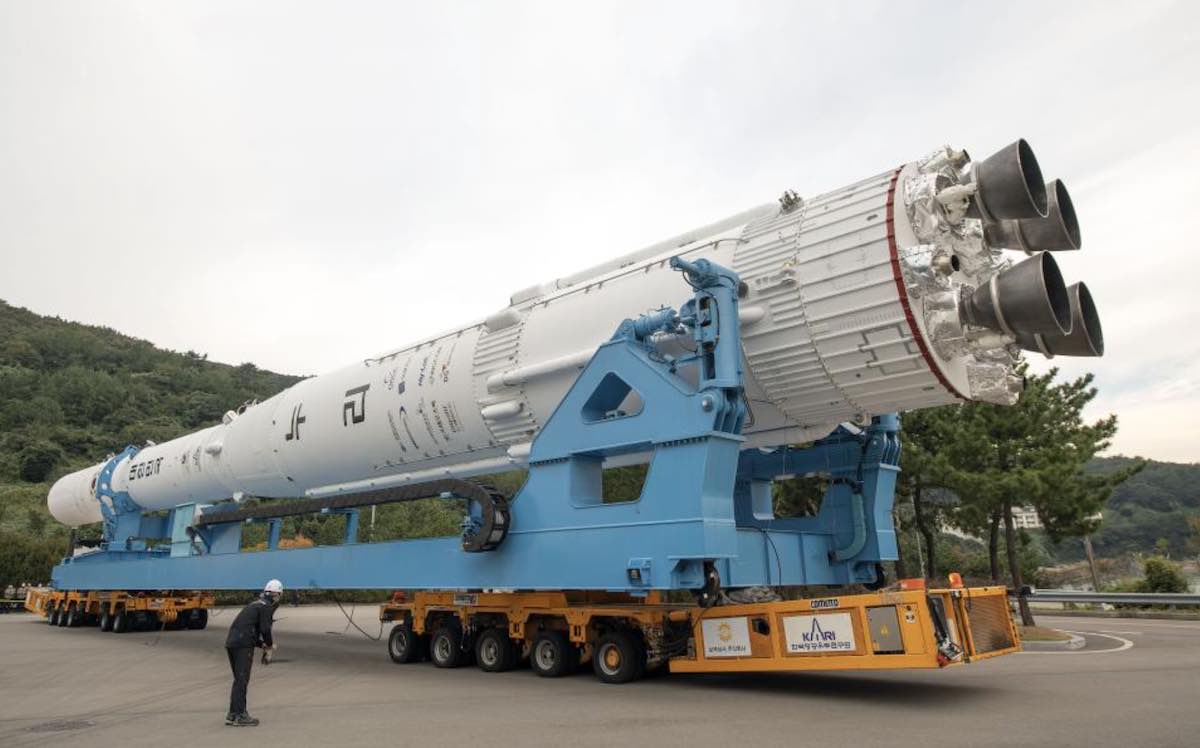South Korea’s first domestically produced satellite launcher failed to reach orbit on its inaugural test flight Thursday. A preliminary review of data indicated the rocket’s third stage shut down early, the Korea Aerospace Research Institute said.
The Nuri rocket lifted off from the Naro Space Center, built on an island nearly 300 miles (500 kilometers) south of Seoul at 4 a.m. EDT (0800 GMT). Managers delayed the launch an hour to evaluate valves in the rocket, Korean officials said.
The launch team at the Naro Space Center loaded kerosene and liquid oxygen propellants into the three-stage rocket a few hours before liftoff. After a smooth terminal countdown, four KRE-075 engines ignited with nearly 600,000 pounds of thrust to propel the Nuri launcher off the seaside launch pad.
The rocket arced downrange south from the Naro Space Center, and exceeded the speed of sound in less than a minute. A tracking camera view streamed live on YouTube by South Korea’s science ministry showed the rocket soaring into a clear sky over the Korean coastline, where liftoff occurred at 5 p.m. local time.
Two minutes after launch, the first stage’s four engines shut down. The booster jettisoned moments later, and a single KRE-075 engine on the Nuri’s second stage ignited to continue the climb into space. The live video continued tracking the rocket into the second stage burn.
The rocket’s payload fairing, or nose cone, jettisoned as planned nearly four minutes into the flight, officials said. And the rocket’s third stage, powered by a smaller KRE-007 engine, ignited to accelerate to an orbital velocity near 17,000 mph, or about 7.5 kilometers per second.
But the liquid-fueled third stage engine shut down prematurely, leaving the rocket short of orbital velocity, according to the Korea Aerospace Research Institute, which managed development of the Nuri rocket.
KARI, South Korea’s space agency, said in a statement that Nuri rocket’s flight was “carried out normally” until the third stage engine firing.
The KRE-007 engine shut down after operating for 475 seconds, or nearly eight minutes. That’s 46 seconds shy of the engine’s planned firing time.
“Today’s launch was disappointing, but as the first flight test of a launch vehicle developed independently in Korea, it has the significance of fulfilling all major launch steps and securing core technology,” KARI said. “And this is a result that shows that Korea has accumulated a considerable level of rocket technology.”
The Nuri rocket’s third stage and the satellite mock-up it carried into space reached the mission’s target altitude of 435 miles (700 kilometers), KARI said. But it did not gain enough speed to enter a stable orbit, and the rocket and payload fell back to Earth, likely burning up in the atmosphere during re-entry.
KARI said it will establish a committee to identify the cause of the premature shutdown of the third stage. Engineers will correct the problems before the second Nuri test launch.
In a speech at Naro Space Center after the launch, South Korean President Moon Jae-in lauded the achievements of Korean engineers who designed and built the Nuri rocket.
“Our intended orbit has not been achieved, and this remains to be achieved going forward,” Moon said. “However, I believe that it is very meaningful that we have sent our Nuri and dummy satellite to 700 kilometers above Earth.”

The Nuri rocket, also known as the KSLV 2, stands nearly 155 feet (47.2 meters) tall and measures around 11.5 feet (3.5 meters) in diameter. The Nuri, which means “world” in Korean, is designed to place a payload of up to 3,300 pounds (1,500 kilograms) into an orbit more than 372 miles (600 kilometers) in altitude.
South Korean officials plan to launch the second Nuri rocket next May. That mission will be the first Nuri flight to carry a real satellite into orbit.
The launch of South Korea’s first Nuri rocket comes nearly nine years after the only successful launch of the Naro 1 booster. South Korea launched three Naro 1 rockets from the Naro Space Center, but the first two flights in 2009 and 2010 failed shortly after liftoff.
The third Naro 1 mission Jan. 30, 2013, successfully deployed a small South Korean technology demonstration satellite into orbit, making South Korea the 11th country to launch its own satellite into orbit, but the feat was not accomplished without international help.
Russia’s space contractor Khrunichev developed the Naro 1’s first stage, and the booster’s kerosene-fueled RD-151 main engine was built by NPO Energomash, another Russian company.
Korea Aerospace Industries led the South Korean industrial team responsible for developing the Nuri rocket.
The rocket’s KRE-075 engines, developed by the South Korean company Hanwha Aerospace, each use a gas generator to drive a pump feeding propellant into the thrust chamber. SpaceX’s Merlin engines, which power the Falcon 9 rocket, use a similar design.
More than 300 South Korean companies participated in the Nuri rocket program. The 12-year effort has cost about $1.7 billion.
“We have had no help from other countries,” Moon said through an interpreter. “Rather, we were able to develop this highly sophisticated launch vehicle with our own technology.”
South Korea’s space industry has grown in the last decade with the advancement of the country’s domestic satellite manufacturing base. The first two geostationary satellites built in South Korea launched in 2018 and 2020 on weather monitoring and oceanography missions.
The Korea Pathfinder Lunar Orbiter is scheduled to launch in 2022 on a SpaceX Falcon 9 rocket. The spacecraft is being manufactured in South Korea, and will carry a payload of Korean and U.S. science instruments to study the moon.
KARI also has a roadmap to develop a bigger satellite launcher after debuting the Nuri rocket.
“If our Nuri rocket is successful going forward, we can also take a big step forward and usher in a new era,” Moon said. “I will make sure that we will have a long term investment to make this possible.”
Email the author.
Follow Stephen Clark on Twitter: @StephenClark1.
